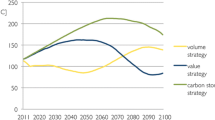Abstract
This paper discusses and contrasts two mainroles of forestry in light of the debate on theglobal climate. As the main problem is relatedto the increases of the CO2-concentrationin the atmosphere, forests may be viewed aspart of the alleviation of the problem throughtheir function as (i) a source of biomass forenergy production, which may replace fossilfuels and thus indirectly reduceCO2-emissions, and as (ii) carbon storage,since a growing forest extracts atmosphericCO2 and fixes it as carbon in biomass. Inthe Scandinavian forestry, logging residues areincreasingly being used for energy production.In this paper the value of forests as a sourceof bioenergy is added to the traditional timbervalue. Formulated as a joint production modelwithin the Faustmann framework, the effect ofthis addition on the optimal rotation length isdiscussed. Based on data for spruce, thedominant species in the Scandinavian forestry,it is demonstrated that the rotation length isshortened compared to the standard Faustmannmodel. Shorter rotation length implies lesscarbon storage. Therefore, in this modelwithout explicit regard to the social carbonstorage value of the forest, the gains in termsof the climate problem from utilisation offorest biomass for energy production are beingdiminished by the value of reduced carbonstorage. The carbon value of the forest is thenadded to complete the model, with the effect ofincreasing the rotation length, a result thatis well known in the literature. Finally, theempirical effects of the interaction of thesetwo climate-related value elements of theforest are discussed.
Similar content being viewed by others
References
Bjørnstad, E. (1999), Energy Biomass from the North-Trøndelag Forestry. Quantities and Costs. North-Trøndelag ResearchInstitute. Report 1999:1. Steinkjer, Norway.
Clark, C. (1990), Mathematical Bioeconomics (2nd ed.). New York: John WileyInterscience.
Clarke, H. R. and R. M. Shrestha (1986), ‘Long-run Equilibrium Properties of Renewable Resource Management Models’,Resources and Energy 8, 279–308.
Englin, J. and J. M. Callaway (1993), ‘Global Climate Change and Optimal ForestManagement’, Natural Resource Modeling 7, 191–202.
Hartman, R. (1976), ‘The Harvesting Decision When a Standing Forest HasValue’, Economic Inquiry 14, 52–58.
Li, C.-Z. and K.-G. Löfgren (2000), ‘A Theory of Red Pine (Pinus koraiensis)Management for Both Timber and Commercial Seeds’, Forest Science 46, 284–290.
Marklund, L. G. (1988), Biomass Functions forPine, Spruce and Birch in Sweden. Department of Forest Survey Report 45. Umeå: Swedish University of Agricultural Sciences.
NILF- Norwegian Agricultural Economics Research Institute (2000), Handbok for driftsplanlegging 2000/2001. NILF, Oslo.
NoBio (2001), Website for the Norwegian Bioenergy Association, www.nobio.no.
Norsk Treteknisk Institutt (1991), Treteknisk håndbok. Teknisk småskrift nr.33. Norsk Treteknisk Institutt, Oslo.
Näslund, B. (1969), ‘Optimal Rotation and Thinning’, Forest Science 15, 446–451.
Plantinga, A. J. and R. A. Birdsey (1994), ‘Optimal Forest Stand Management when Benefits are Derived from Carbon’, Natural Resource Modeling 8, 373–387.
Reed, W. (1986), ‘Optimal Harvesting Models in Forest Management - a Survey’, NaturalResource Modeling 2, 55–79.
Samuelson, P. A. (1976), ‘Economics of Forestry in an Evolving Society’, Journal of EconomicInquiry 14, 466–492.
Sedjo, R.A. (1997), ‘The Economics of Forest-based Biomass Supply’, Energy Policy 25, 559–566.
Statistics Finland (2000), Energy Statistics. On web site, www.stat.fi.
Statistics Norway (2000), Energy statistics. On web site, www.ssb.no.
Statistics Sweden (2000), Energy statistics. On web site: www.scb.se.
Swallow, S. K., P. J. Parks and D. N. Wear (1990), ‘Policy-Relevant Nonconvexities in the Production of Multiple Forest Benefits’, Journal of Environmental Economics and Management 19, 264–280.
van Kooten, G. C. (2000), ‘Economic Dynamics of Tree Planting for Carbon Uptake on Marginal Agricultural Lands’, CanadianJournal of Agricultural Economics 48, 51–65.
van Kooten, G. C. and E. Bulte (2000), The Economics of Nature. ManagingBiological Assets. Oxford: Blackwell Publishers.
van Kooten, G. C., C. S. Binkley and G. Delcourt (1995), ‘Effect of Carbon Taxesand Subsidies on Optimal Forest Rotation Age and Supply of Carbon Services’, American Journal of Agricultural Economics 77, 365–374.
Author information
Authors and Affiliations
Corresponding author
Rights and permissions
About this article
Cite this article
Bjørnstad, E., Skonhoft, A. Wood Fuel or Carbon Sink? Aspects of Forestry in the Climate Question. Environmental and Resource Economics 23, 447–465 (2002). https://doi.org/10.1023/A:1021379306349
Issue Date:
DOI: https://doi.org/10.1023/A:1021379306349




